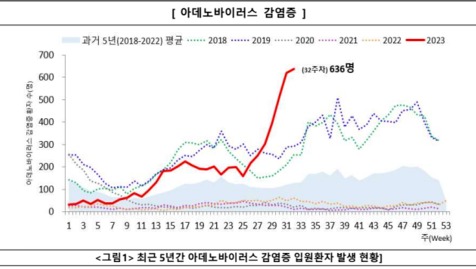Infection
More infants, toddlers coming down with adenovirus infections: KDCA
An increasing number of Korean children aged six or younger are suffering from adenovirus infections, presenting cold symptoms like fever, cough, and pink eye, the government said.
According to the Korea Disease Control and Prevention Agency (KDCA), the number of hospitalized individuals with adenovirus infections in the Aug.6-Aug.12 week shot up to 636, more than double the number showed in the same period of 2018 (258) and 2019 (292).
Also, the agency’s sample surveillance of nine types of acute respiratory infections showed that the proportion of patients with adenovirus infections among respiratory outpatients at hospitals and clinics was 28.5 percent in the second week of August, more than double from 13.7 percent shown three weeks ago.
Adenovirus infections are most common in infants and children up to age six.
Children aged from zero to six account for 89 percent of those hospitalized for adenovirus infection.
Adenoviruses have the potential to spread through respiratory droplets, direct contact with an afflicted individual, and during the process of changing the diaper of an infected infant or child.
The contagion is significant enough to be transmitted through the sharing of towels, toys, and various articles among immunocompromised infants and young children. Additionally, transmission can occur in aquatic environments like swimming pools.
Apart from affecting the respiratory tract, adenoviruses can also target the eyes and gastrointestinal tract. Thus, alongside typical cold-like symptoms such as fever, cough, and a runny nose, individuals may experience signs of gastrointestinal infections. These include epidemic keratoconjunctivitis, characterized by eye redness and crusting, as well as sensations of nausea, vomiting, and diarrhea. In more severe instances, the virus can result in complications like hemorrhagic cystitis and pneumonia.
“To promote a healthy summer for infants and young children, it’s crucial to uphold proper hygiene measures. This includes thorough handwashing with soap for a minimum of 30 seconds before and after outdoor activities, diaper changes, water play, and food preparation. Additionally, practicing cough etiquette, and whenever feasible, donning masks in crowded settings, can significantly contribute to maintaining well-being,” KDCA Commissioner Jee Young-mee said.
At home, she advised that people should educate families about preventive measures, including the significance of thorough handwashing, refraining from touching the eyes with unwashed hands, and practicing proper cough etiquette, she added.
In facilities such as childcare centers and kindergartens, where infants and toddlers share spaces, people need to prioritize disinfection by employing suitable disinfectant solutions, she emphasized.

